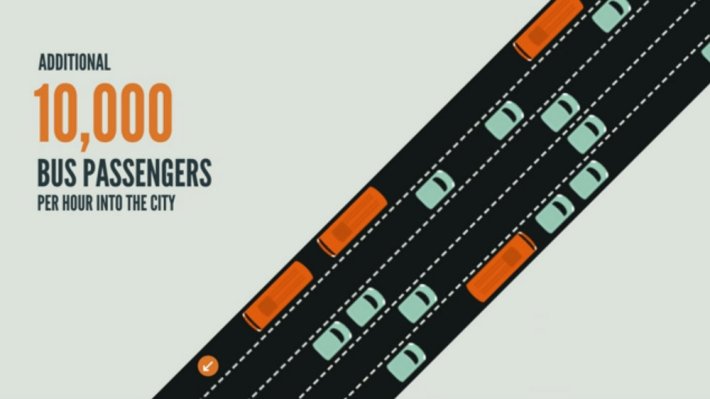The proposal to improve transbay transit with a contraflow bus lane on the Bay Bridge is gaining traction, as the SF Chronicle reported yesterday. The idea has been pushed by proponents at SPUR, AC Transit, and some BART board members for years as a relatively quick and inexpensive solution to move more people between SF and the East Bay. BART is already experiencing "crush loads" under the Bay, but a second transbay tube may not come for decades.
As SPUR explained in a video in 2011, converting an eastbound traffic lane into a westbound bus-only lane during morning commute hours could move an additional 10,000 bus riders per hour -- "almost the entire capacity on the entire upper deck" of the Bay Bridge -- on AC Transit's 30 transbay lines, which currently carry an estimated 14,000 passengers per day. It would require the construction of new bus ramps, including one to connect to the Transbay Transit Center in SF.
"With our packed capacity, and all of the development in the Transbay area and [Transbay Center] nearing completion, we're going to really need that bus capacity," said Tom Radulovich, a BART board member and director of Livable City. "Building a shiny, multi-billion dollar terminal and having those buses stuck in traffic doesn't make a lot of sense."
The biggest barrier to implementing the idea is convincing Caltrans, which has jurisdiction over the Bay Bridge, said Radulovich. According to him, the agency has said that the contraflow lane is unnecessary because it can manage car congestion through ramp metering. Caltrans didn't respond to a request for comment.
As the Chronicle noted, Bay Bridge buses would be too mired in car traffic within 20 years to be competitive with driving, according to a 2011 study that proposed solutions for the bridge crossing. The contraflow lane is being studied in more detail in the Metropolitan Transportation Commission's Bay Area Core Capacity Transit Study, due out by 2017.
New York City has had a contraflow morning bus lane since 1971. The 2.5-mile Lincoln Tunnel Exclusive Bus Lane carries 62,000 passengers each day, more people than any other segment of roadway in the United States, as illustrated in this Streetfilm. It saves each bus passenger 20 minutes, according to a report from the Transportation Research Board [PDF].
The Bay Bridge lane conversion and ramps could cost anywhere between $51 million and $177 million, according to the Chronicle. Another potential hurdle to clear is ensuring that the ramp to the Transbay Center won't be blocked by a 16-story building planned at 525 Harrison Street. AC Transit's board president sent a letter in late March [PDF] urging the SF Planning Department not to approve a development that would not encroach on the ramp.
Radulovich said support for the contraflow lane has grown among BART officials who saw the idea as a "rival" that could siphon off train riders. Now that the economic boom has increased BART's daily ridership to record levels of 420,000 -- 100,000 more than five years ago, according to the Chronicle -- BART "thanks goodness [transbay bus service] is there," he said. BART's newest board member, Nick Josefowitz, is also a champion of the idea.
"I think the consensus in the region, even among other 'rival' transit operators, that AC Transit transbay service is important, is growing," said Radulovich.






